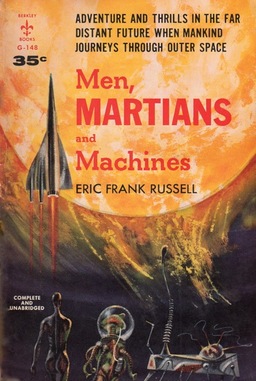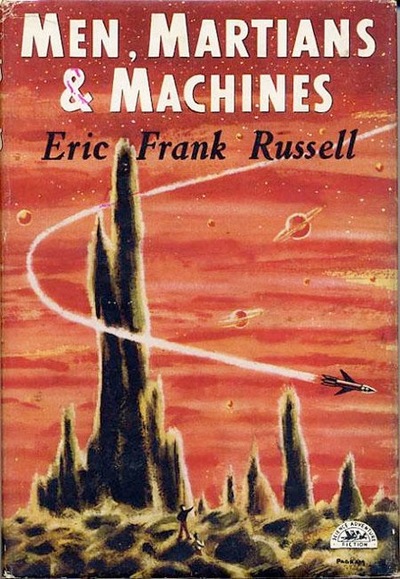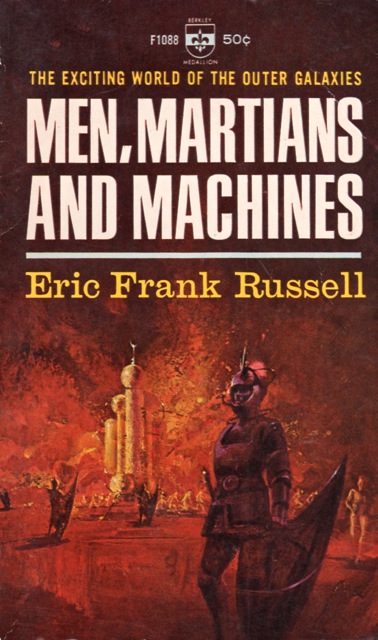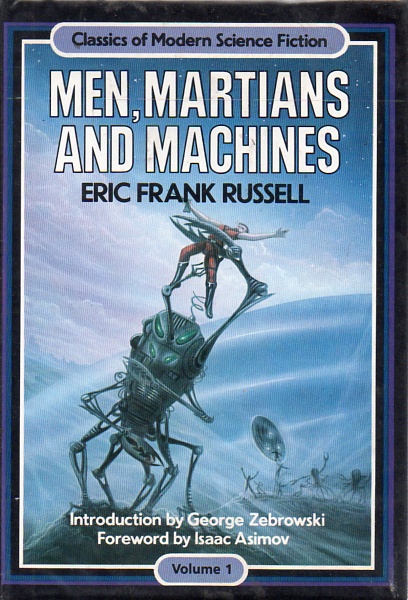Vintage Treasures: Men, Martians, and Machines by Eric Frank Russell
 Last Sunday, I posted the latest article in my Ace Double series, this time focusing on Sentinels of Space by Eric Frank Russell and Don Wollheim’s The Ultimate Invader.
Last Sunday, I posted the latest article in my Ace Double series, this time focusing on Sentinels of Space by Eric Frank Russell and Don Wollheim’s The Ultimate Invader.
It made me realize that I’ve given precious little coverage to Eric Frank Russell over the years — really, a pretty serious oversight, considering what a fine writer he was. So I thought I’d remedy that here, starting with his 1955 volume Men, Martians, and Machines.
Men, Martians, and Machines is something of a problem child for catalogers. Wikipedia lists it as a novel, but it’s really not — it’s a collection of four linked stories, three published in Astounding during World War II, and one original. The Internet Speculative Fiction Database entry for Russell lists it as neither a collection nor a novel, creating a separate category for it.
In some ways the book is an early precursor to Star Trek. The stories follow the exploits of the rough-and-tumble crew of the solar freighter Upskadaska City, known more commonly as the Upsydaisy, who follow their Captain as he takes charge of one of the first faster-than-light starships, the Marathon. Captain McNulty leads his mixed crew of humans, jovial tentacled Martians, and one robot on voyages of discovery to far stars and strange alien planets.
Star Trek fans will certainly enjoy these proto-Trek stories and see how they influenced that seminal series two decades later. For me, these tales represent something even more primal. When I think of Golden Age robot stories, I think of Asimov; when I think of military science fiction, I think Heinlein. When I think of tales of brave exploration and camaraderie in the face of the vast mystery and terror of deep space, I think of Eric Frank Russell.
It’s his unique voice, I think, and the poetry and humanity of his prose, mixed with all the marvelous ray-gun trappings of pulp science fiction, that makes him such a joy to read. Here’s a snippet from the first story, “Jay Score,” as our unnamed narrator meets with the imposing new emergency pilot shortly after blast off.
Didn’t see anything more of Jay Score until we were two hundred thousand out, with Earth a greenish moon at the end of our vapour-trail. Then I heard him in the passage asking someone where he could find the sergeant-at-arms. He was directed through my door.
“Sarge,” he said, handing over his official requisition, “I’ve come to collect the trimmings.” Then he leaned on the barrier, the whole framework creaked and the top tube sagged in the middle.
“Hey!” I shouted.
“Sorry!” He unleaned. The barrier stood much better when he kept his mass to himself.
Stamping his requisition, I went into the armoury, dug out his needle-ray projector and a box of capsules for same. The biggest Venusian mud-skis I could find were about eleven sizes too small and a yard too short for him, but they’d have to do…
The way he eyed the space-suits seemed strangely wistful… there wasn’t a suit for him. I couldn’t have fitted him with one if my life depended on it. It’d have been like trying to can an elephant.
Men, Martians, and Machines was originally published in hardcover in 1955 from UK publisher Dennis Dobson. (Who?) The cover art by Pagram is crude and just barely above fan art, yet it somehow manages to perfectly capture the spirit of Golden Age science fiction for me:
The book appeared in the US for the first time in August 1958, in a paperback edition from Berkley. That’s the Richard Powers cover at top; here’s the blurb from the back cover:
High Adventure Among the Stars
In this book you will journey through the cosmos on the space-ship Marathon — the most remarkable creation of Man’s genius in all history. Powered by the fantastic Flettner system, the Marathon moved faster than the speed of light, and for the first time exploration of the outer galaxies became possible.
Here are the adventures of the far-distant future that will thrill and delight every reader of science fiction. As the Marathon makes its incredible voyages and encounters civilizations and life forms that stagger the imagination, you will find yourself in the grip of one of the most fascinating reading experiences you have ever encountered.
 In his marvelous retrospective of 20th Century SF Past Masters, our own Bud Webster does a better job than I could explaining what made Men, Martians, and Machines so special, including Russell’s casual use of a mixed-race crew.
In his marvelous retrospective of 20th Century SF Past Masters, our own Bud Webster does a better job than I could explaining what made Men, Martians, and Machines so special, including Russell’s casual use of a mixed-race crew.
There’s another book I constantly and consistently saw in the used bookshops I used to haunt that’s almost as well-known, if not more famous [than Sinister Barrier]. That book, one of my own all-time favorites, is Men, Martians and Machines. A collection of stories about a man/robot named Jay Score (J20 in his robotic persona), this was not only my first introduction to aliens and humans working together (predating Star Trek by most of a decade), but also the first time to my knowledge that an African-American had been featured as ship’s crewman (in this case the doctor). There was a reason for this in Russell’s plot-line — apparently, no Negroes (as was then the respectful term) ever got space sick. Don’t forget this was the early ’40s, a time when the depiction of African-Americans in popular culture was still less than courteous, and an African-American as a serious character who did nothing in the way of either shucking or jiving was rare indeed, not to mention pretty cool. I don’t necessarily think that Russell was trying to make a major point, or to showcase his (comparative) broad-mindedness; I just don’t think he felt that a Negro had to be portrayed as a Steppin Fetchit caricature instead of a reasonable human being. If this be Libertarianism (or — say it softly! — Liberalism), then so be it.
Jay Score is a big, quiet man in the middle of a crew of characters who border on the wacky, and occasionally edge all the way into zany. One might even call them madcap, if one were inclined to do so. Most of them are human, but a few are Martians, and they’re just as wacky/zany/madcap as the regular folk are.
Don’t get the idea that they’re all that two-dimensional, however. They’re fun, and funny, but Russell’s skill even in a series of yarns tossed off to make John Campbell laugh is evident, and if they don’t exactly leap out of the story and dance around the room, they nevertheless work just fine on the page. I especially like the Martians, haughty and sarcastic, playing chess at every opportunity and complaining about the thick (to them) atmosphere, who still manage to get their work done and act just as heroically in defense of their non-tentacled shipmates as they do to protect themselves. Zany individuals the crew and officers may be — this is Russell, after all — but they are first and foremost a crew…
I re-read this one at least once a year, with as much delight and amusement as I got from it the first time.
See Bud’s complete article on Eric Frank Russell here.
Berkley Medallion brought Men, Martians, and Machines back into print a decade after it originally appeared in May 1965, with an attractive Paul Lehr cover.
It was reprinted one final time in 1984 by Crown, as the first volume of their new hardcover Classics of Modern Science Fiction line (which eventually stretched to ten volumes, including Murray Leinster’s The Forgotten Planet, Charles L. Harness’s The Paradox Men, and Ward Moore’s Greener Than You Think.)
This volume had a new introduction by George Zebrowski, a foreword by Isaac Asimov, and a very blue cover by Michael Booth.
Men, Martians, and Machines has not seen a print edition since 1984. There is no digital edition.
Here’s the complete table of contents:
“Jay Score” (Astounding Science-Fiction, May 1941)
“Mechanistria” (Astounding Science-Fiction, January 1942)
“Symbiotica” (Astounding Science-Fiction, October 1943)
“Mesmerica” (previously unpublished)
Our most recent Eric Frank Russell coverage includes:
Wasp
Somewhere a Voice
Six Worlds Yonder / The Space Willies
Men, Martians, and Machines
Sentinels of Space
It’s A Small World After All
Creatures From Beyond, edited by Terry Carr
Robert Bloch on J. Francis McComas, Eric Frank Russell, and Leigh Brackett
Men, Martians, and Machines was published by Berkley in August, 1958. It is 174 pages in paperback, priced at 35 cents. The cover was by Richard Powers. Recent copies in good condition sold on eBay for prices ranging from $2.99 – $9.50.
See all of our recent Vintage Treasures here.



Russell was a great writer, and I mean that in the sense of I’ve never read any of his work that I didn’t enjoy. Men, Martians, and Machines is no exception.
His story “Dear Devil”, a post-holocaust story about the friendship between a boy and a Martian (the titular devil) blew my mind. His novel Wasp is a perfect textbook on how to be a nonviolent terrorist. Not surprising since Russell was in the same intelligence unit in World War II as Ian Fleming.
It’s a shame he is better remembered today. His work was full of wit and humor, and it was fun to read.
[…] a few really excellent single author collections recently, including Eric Frank Russell’s Men, Martians, and Machines, Michael Shea’s Polyphemus, and H.P. Lovecraft’s The Dunwich Horror and Others. As long […]
[…] Sentinels of Space (with a brief aside to look at his 1958 paperback collection from Berkley, Men, Martians, and Machines.) So I thought it apropos to examine his first Ace Double pair: Six Worlds Yonder / The Space […]